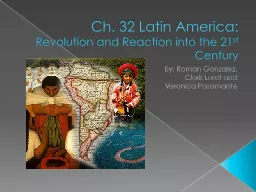

Revolution and Reaction into the 21 st Century By Roman Gonzalez Clark Lurot and Veronica Pasamante Overview Latin America not as involved w WWII Cold war new revolutionary motives ID: 598558
Download Presentation The PPT/PDF document "Ch. 32 Latin America:" is the property of its rightful owner. Permission is granted to download and print the materials on this web site for personal, non-commercial use only, and to display it on your personal computer provided you do not modify the materials and that you retain all copyright notices contained in the materials. By downloading content from our website, you accept the terms of this agreement.
Slide1
Ch. 32 Latin America:Revolution and Reaction into the 21st Century
By: Roman Gonzalez, Clark Lurot and Veronica Pasamante Slide2
OverviewLatin America not as involved w/ WWII
Cold war new revolutionary motivesLatin America continues previous political policiesBolivia, Guatemala, and Cuba experience significant revolutions
Latin America look into many solutions
Social relations change over timeSlide3
Latin America After WWII 1945: Latin American countries dominated by authoritarian reformers
Getulio Vargas BrazilJuan Peron ArgentinaPeronism
Dirty War
1982: Argentina and BritainSlide4
Mexico and the PRIPRI: Party of the Institutionalized Revolution
1994-armed guerilla movement by ZapatistasMexican gov. joins NAFTA2000- national election ends PRI
Vicente Fox becomes president Slide5
Radical Options in the 1950s
Desire to improve social and economic conditions
Revolution, democratic parties, Marxian Socialism
Radical solutionsSlide6
Guatemala
Illiterate, poor health conditions, and high death rateJuan Jose Arevalo
Spiritual
socialism
Colonel Jacob
Arbenz
US government invadesLow amount of reformsViolence and instabilitySlide7
Cuba
Poor working and living conditionsUS very involvedFulgencio
Batista
Fidel
Castro - opposed Batista Government
Socialist regime
Broke off relations with US depended on Soviet Union1960: Industrialization failedSlide8
The Search for Reform and the Military Option Latin America tended to spur revolutions
economic and social themes unchangedPolitical stability to promote economic growthChurch as guideLiberation theology combined Catholic theology and socialist principlesSlide9
Soldiers Take Power
Latin American military more professional
1964- Brazilian military
overthrows
president
1973- Chilean military overthrows socialist government
New regimePresident controlled by militaryViolent opposition in Argentina dirty warPolicies affected working class the mostSlide10
New Democratic Trends
1980s: Governments return to civilian politiciansArgentina
1983 elections
Brazil
1989 elected first president since takeover
Peru
Sendero Luminoso NicaraguaSandinista Party removedSlide11
New Democratic Trends Cont’d
PanamaUS involvementGuatemala1996 civilian governmentHuge amount of debtCommerce in drugs
Well established despite thisSlide12
The United States and Latin America:Continuing Presence
After WWI US emerges as strongest power Intervene greatly in Latin America People resisted presenceAugusto Sandino
Direct intervention banana republic
Foreign interventions nationalist reaction
Good Neighbor PolicySlide13
Continuing Presence Cont’d
Alliance for Progress1970s: Friendlier relations with Latin America1980s: Back to interventionMost aid went to military left workers unprotectedSlide14
Societies in Search of Change
Social and gender relations slowly change in Latin AmericaSought to give Indian populations the right to voteSlide15
Women’s RolesAfter WWI women remained inferior
Given right to vote Feminist organizations brought changePrejudices limited political influenceLarge numbers entered the labor forceActive politically
1990s
:
women had a position similar to Western EuropeSlide16
The Movement of PeoplePopulations increased dramatically
Immigration to Latin America and internal immigrationGovernments supply laborers illegal immigrationPolitics major reason for migration
R
ural to Urban
Rapid rate of growthSlide17
Cultural Reflections of Despair and Hope
Family, gender roles, business, and social interaction influence life
Culture thrives through crafts, images, and music
Powerful
realist novels
“Magical
realism”